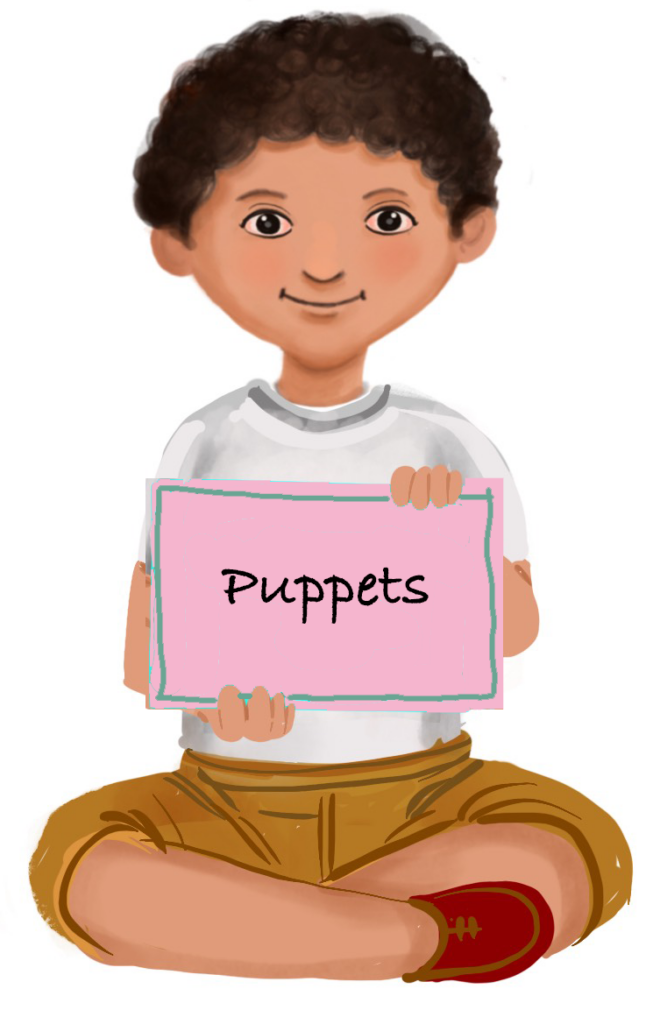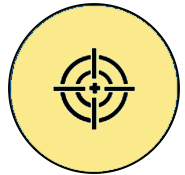
Socks Puppet – Man
 Objective
Objective
To guide teachers in creating a puppet of a man for story-telling and other educational purposes.
Estimated time to create the Socks Puppet – Man
60 to 90 Minutes
Materials required for creating Socks Puppet – Man
- White Chart paper- for the Eyes, mouth
- Hard stock paper for paper pipe
- Rectangular shaped cloth for the body part of the puppet
- Needle and thread for stitching the body
- Sock – 1 no.
- Cotton Roll
- Marker Pens – Black and Red
- Pencil and Eraser
- Creepers for hair
- Thick Threads for tying
- Stapler with pin
- Fevicol
- Scissors
Preparation for Activity
Keep all the materials ready in advance. If you are using hot glue instead of Fevicol, ensure that the hot glue is heated suitably and is ready for use.
Procedure
- First, we will make the dress or body of the puppet. Take a piece of cotton cloth, fold it in half and spread it on a flat surface.
- Draw the outline of the puppet’s body (including the neck, arms and torso), then cut along the outline using scissors. You will now have two identical pieces of cloth.
- Turn both pieces inside out, place them one over the other (with the good side facing inward) and stitch along the sides of the body and arms. Leave the neck opening at the top and the bottom edge open. Fold about half an inch along the open edges and stitch to finish them neatly. Ensure that the openings are not closed.
- Head: To make the head, first roll a strip of thick paper into a strong pipe. Apply fevicol around one end of the paper pipe, covering about one inch of its length. Take a handful of cotton and press it onto the glued area, holding it firmly for a few seconds. Repeat the process, adding more layers of cotton until a ball shaped head is formed. Allow it to dry completely.
- Cut and remove the upper portion of a sock. Insert the cotton ball with the attached pipe into the sock, placing it firmly at the bottom.
- Take three small pieces of cotton, shape them into ears and a nose, and insert them into the sock at the correct positions on the cotton ball. Stitch them securely to the sock to keep them in place.
- On a piece of white paper, draw and cut out shapes for the eyes and lips. Paste them onto the face using fevicol. Use a black marker pen to draw the eyes and a red marker pen for the lips.
- For the hair, cut creepers to the required length and fix them onto the head part of the sock using fevicol.
- Cut two equal-sized pieces of creepers for the moustache and fix them below the nose.
- Similarly, cut and fix creepers for the eyebrows. Now, the puppet’s head is ready.
- Hold the head firmly and tie a knot using a thick thread just below the cotton ball to secure it. (Note: The finger pipe inside the sock will be used to control the head movements.)
- With the tied ball portion of the sock remaining outside, insert the rest of the sock through the neck opening of the dress. While still holding the head above the neck opening, tie the sock securely to the dress using a thick thread.
- Draw and cut out the shape of the hands from white paper. Fix them at the ends of the arm projections, ensuring the thumbs face upwards.
- Allow a few minutes for everything to dry. Your glove/sock puppet is now ready.
- To use the puppet: Insert your forefinger (index finger) into the paper pipe to move the head, your thumb into one arm projection and the remaining fingers into the other arm projection.
- Move your fingers to demonstrate the hand and head movements of a man.
Step by Step Pictures to create the puppets
Important Tips
- The dress can be stitched by hand using a needle and thread or it can be tailor-made.
- Black coloured paper can be used for the hair instead of using ‘creepers’ (artificial hair typically used in drama make-up).
- To speed up the gluing process, glue drops, a glue gun or a stapler can be used instead of fevicol.
- Wedding cards or book covers can be good alternatives to drawing sheets.
- Reference images from drawing books or the internet can be helpful while designing the puppet.
- While creating the puppet, try to replicate the character illustration from the children’s textbook. Once the puppet is ready, refer to it by the character’s name from the textbook. This helps children connect with the content and improves recall.
- The teacher should use the puppet at an appropriate time, perhaps while narrating the story in a funny and humorous way. Intentional mistakes can also be made to encourage children to correct them, making the session more interactive and engaging.
Precautions
Precautions to be taken while manipulating finger puppets:
- Always keep the puppet’s face directed towards the audience.
- The Puppet Master’s focus should remain on the puppet at all times.
- Only the puppet that is ‘speaking’ should be animated; all other puppets should remain still.
 Notes to the Teacher
Notes to the Teacher
Puppets can be effectively used in the classroom to help children understand and express emotions. They are also valuable tools for teaching rhymes, songs, stories and more.
In addition to enriching learning experiences, using puppets supports the development of motor skills such as hand-eye coordination. They also enhance communication and social skills, improve focus and concentration, and help reinforce concepts and values in an engaging way.
Using the Learning Teaching Material
The teacher can demonstrate a puppet show as an example. Students can then be encouraged to create their own puppets and present a puppet show in the classroom.
Video: How to use Learning Teaching Material
| Source and Attribution of images All images used in the above Assets and Aids are originally created. |
| This digital material has been developed by the Sri Sathya Sai Vidya Vahini Inclusive Education Project, a unit of Sri Sathya Sai Central Trust, Prasanthi Nilayam, as a collaborative offering in the service of our nation. |